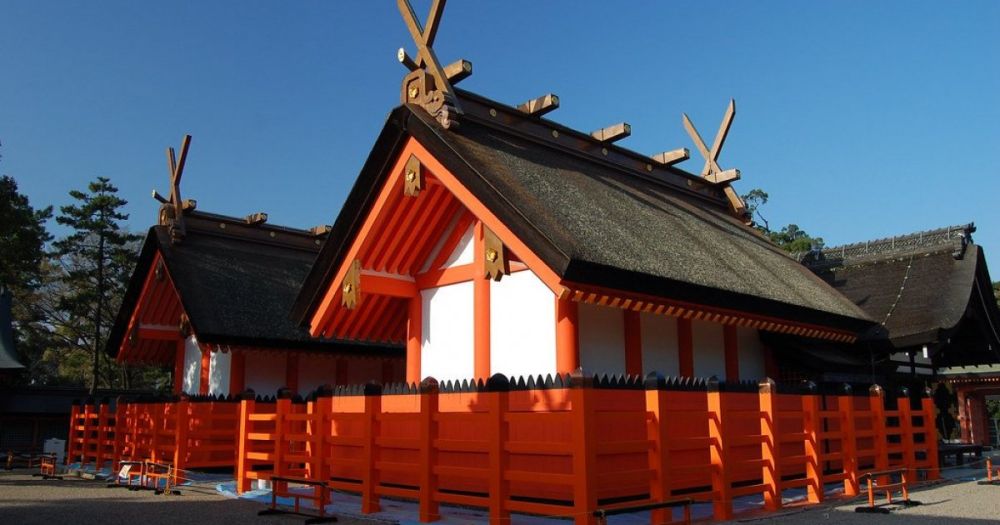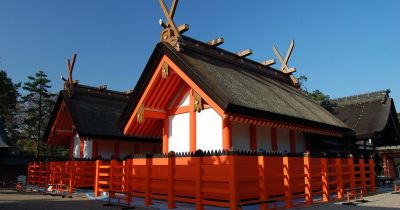

The visit to the Sumiyoshi Taisha's Main Shrine, also known as the Honden, is a spiritual journey into the heart of Shinto tradition. Sumiyoshi Taisha is one of Japan's oldest shrines, and the main shrine complex reverberates with historical significance and serene beauty. The unique architectural style, known as Sumiyoshi-zukuri, is devoid of influence from the Asian mainland and has been designated as a National Treasure. Visitors are often found taking their time to pray, cleanse themselves at the temizuya (purification fountain), and take in the peaceful atmosphere. The shrine is dedicated to the Sumiyoshi Sanjin, deities who protect sailors and sea travelers, making this visit a poignant experience for those interested in maritime history and lore.
Ema are small wooden plaques on which Shinto worshippers write their prayers or wishes. At Sumiyoshi Taisha, visitors can partake in this traditional activity by purchasing an ema at the shrine's administration building. After inscribing their wishes onto the plaque, the ema are hung on specifically designed racks in hopes that the kami, or Shinto deities, will receive their messages. This experience not only provides a personal spiritual connection but also serves as a memorable souvenir. The visitor will be part of an array of ema, each telling a personal story, surrounding the sacred trees within the precinct, and contributing to the vibrant cultural tapestry of the shrine.
Omikuji are random fortunes written on strips of paper at Shinto shrines and Buddhist temples in Japan. The Sumiyoshi Taisha Shrine offers this cultural fortune-telling experience, where visitors can try their luck and seek guidance from the divine. After giving a small offering, participants shake a container filled with numbered sticks until one falls out. The number corresponds to a drawer containing the omikuji, which will reveal the person's fortune ranging from great blessing to great curse. Some people tie their omikuji around trees or designated strings at the shrine if the fortune is not favorable, in the hope that the bad luck will be averted by the divine spirit.
Sumiyoshi Taisha Shrine hosts various significant festivals throughout the year, attracting visitors wanting to partake in the seasonal traditions and ceremonies. One of the most important is the Sumiyoshi Matsuri, held annually in late July to early August, featuring traditional Shinto rituals, a procession of divine palanquins (mikoshi) and boat races. Another notable event is the Hatsumode during New Year's Day, when the shrine becomes a focal point for locals to offer their first prayers of the year. Experiencing a traditional festival at Sumiyoshi Taisha allows visitors to immerse themselves in the living cultural heritage and communal spirit unique to Japan.
The iconic Sorihashi Bridge, also known as the Taiko-bashi, is one of the most recognizable features of Sumiyoshi Taisha Shrine. This arched bridge spans the pond leading to the main entrance and symbolizes the path from the physical to the spiritual world. As visitors ascend the steep slope of the bridge, it is said that they are purified and their worldly thoughts are cleansed before reaching the sacred precincts. Crossing this bridge is a contemplative activity that prepares one for the serenity of the shrine grounds and is a popular spot for taking photos to remember the visit by. Amidst the natural beauty surrounding it, the bridge provides a moment of reflection and a magnificent view of the shrine scenery.
Goshuin are seals or stamps collected in a special booklet called a goshuincho, which serve as a record of visits to temples and shrawns throughout Japan. At Sumiyoshi Taisha, visitors can bring their own goshuincho or purchase one on-site to receive the unique stamp and calligraphy written by a shrine priest. The act of collecting goshuin is not only a way to commemorate one's visit but also serves as a sign of respect and devotion. Each goshuin contains the name of the shrine, the date of the visit, and other auspicious symbols, creating a personal and beautiful keepsake that becomes more valuable with every entry. The goshuin of Sumiyoshi Taisha is sought after for its distinct design, reflecting the ancient heritage of the shrine.
A traditional tea ceremony can be a meditative and insightful experience, and Sumiyoshi Taisha occasionally offers visitors the chance to participate in one. Although not a daily occurrence, special events or designated days might allow guests to appreciate the art of the Japanese tea ceremony, known as sado or chanoyu. Participants are treated to a ceremonial preparation of matcha, powdered green tea, accompanied by Japanese sweets. The tranquil surroundings of the shrine enhance the experience, allowing a moment of repose and cultural immersion. Attendees learn about the philosophy and aesthetics of sado, which include harmony, respect, purity, and tranquility.
For history enthusiasts or first-time visitors, a guided historical tour of Sumiyoshi Taisha can enrich the visit substantially. Knowledgeable guides explain the significance of the shrine's architecture, which remains free from mainland Asian influence, and recount the legends associated with the deities to whom the shrine is dedicated. The tour might include lesser-known anecdotes, an explanation of the Shinto rituals, and details about the symbolic objects found on the shrine grounds. Visitors thereby gain a deeper appreciation for the importance of Sumiyoshi Taisha in Japan's religious and cultural landscape. Tours are generally conducted in Japanese, but there might be English-speaking guides available upon request or with prior arrangement.
Throughout the year, Sumiyoshi Taisha Shrine grounds become a tapestry of blooming flowers, offering visitors an opportunity to enjoy seasonal flower viewing—known in Japan as hanami. In spring, cherry blossoms (sakura) create a canopy of soft pink, while the summer months bring vibrant iris flowers, adding color to the verdant landscape. The autumn ushers in a shift to deeper hues with the changing leaves of maples. Participating in hanami at the shrine provides not only a feast for the eyes but also a traditional cultural experience. Visitors are often seen picnicking under the blossoms or simply strolling along, enjoying the transient beauty of nature.
Shimenawa are traditional sacred ropes made from rice straw or hemp, symbolizing the boundary to sacred space in Shinto religion. Sumiyoshi Taisha occasionally offers workshops where participants can learn to make their own shimenawa, understanding its spiritual significance while engaging in a hands-on crafting session. Visitors create a miniature version that they can take home as a protective charm or decoration. The workshops typically include a short introduction to the history and meaning of the shimenawa, followed by a step-by-step guide to braiding and knotting the ropes into the completed form. It is a unique cultural activity that provides insight into Shinto rituals and customs.
